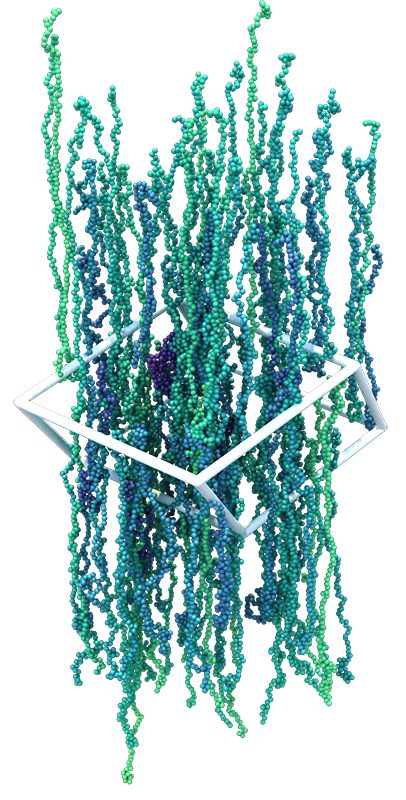Welcome to the self-assembled jungle
Thomas O’Connor finds that all hope is not lost for working with, processing, and one day recycling self-assembled materials.

Source: College of Engineering
Associating polymers are made of long molecular chains that contain sticky groups along their length. The sticky groups are attracted to each other and aggregate to form clusters that connect different chains together into a network.
When plastic materials are processed or recycled, their fundamental properties can degrade due to damage caused by deformation. Recycling processes tend to break molecular bonds inside the materials, making them weaker and less durable. One way that plastics can be made more sustainable is by using self-assembled soft materials that can self-heal after damage. Self-assembled materials spontaneously organize and can reform molecular connections after being damaged, allowing the materials to recover their strength over time. Many researchers are exploring applications of self-healing materials where plastic components are difficult to replace or repair, like nanotechnology inside computers or biomedical materials inside human bodies. However, scientists do not have a thorough understanding of their behavior at the molecular scale.
Thomas O’Connor, an assistant professor of materials science and engineering, is working to change that. He and his team of collaborators are using molecular simulations to study a type of self-assembling materials called associating polymers. These polymers are made of long molecular chains that contain sticky groups along their length. The sticky groups are attracted to each other and aggregate to form clusters that connect different chains together into a network that might look like a bowl of molecular noodles. When the polymers are damaged by deformation, the sticky clusters can reform and heal the material by forming a molecular scar. Stickier clusters can form stronger scars, but if the sticky interactions become too strong, very large clusters will form, and the polymer will become too rigid to manipulate in manufacturing.

Source: College of Engineering
When O’Connor stretched the polymer chains, he found that the largest and strongest clusters tended to break up and allow chains to flow like a liquid, while other weaker clusters would not break and prevented chains from elongating.
To understand how associating polymers behave when stretched, O’Connor simulated the behavior of polymer chains during elongational deformation. He found that as he stretched the networks, sticky clusters inside the material did not react in a uniform way. The largest and strongest clusters tended to break up and allow chains to flow like a liquid, while other weaker clusters would not break and prevented chains from elongating. This heterogeneous response—different molecular behaviors from the same stimulus—is exciting to materials theorists like O’Connor because it helps explain why these materials are so unpredictable during manufacturing.
“Typically, the way you write a theory for a material is to ask, what is the average response of the polymer chains to what I am doing?” O’Connor explained. “But with this network there are two distinct behaviors happening. Some chains are stretched out and some chains are collapsed. The average would be somewhere in the middle and won’t capture either.”
Conversely, when O’Connor sped up the simulation to stretch the polymer chains more quickly, he found that the faster the chains were stretched, the more similarly they all behaved. At high speeds, the clusters that acted as permanent connections broke apart and formed many smaller clusters with similar properties to the smaller clusters already in existence. “This showed us that all hope is not lost for working with, processing, and one day recycling self-assembled materials.” O’Connor elaborated. “While these systems have a new and messy way of behaving, this messiness follows some rules because the way the system breaks up creates a kind of self-organization. I am looking forward to exploring what these networks will do when we can more carefully control them.”
Using simulations, O’Connor’s team can precisely control the size and stickiness of the clusters and can evaluate how more carefully architected associating networks will respond to elongational flow. This research published in Physical Review X is foundational toward the future of processing self-assembled materials.
